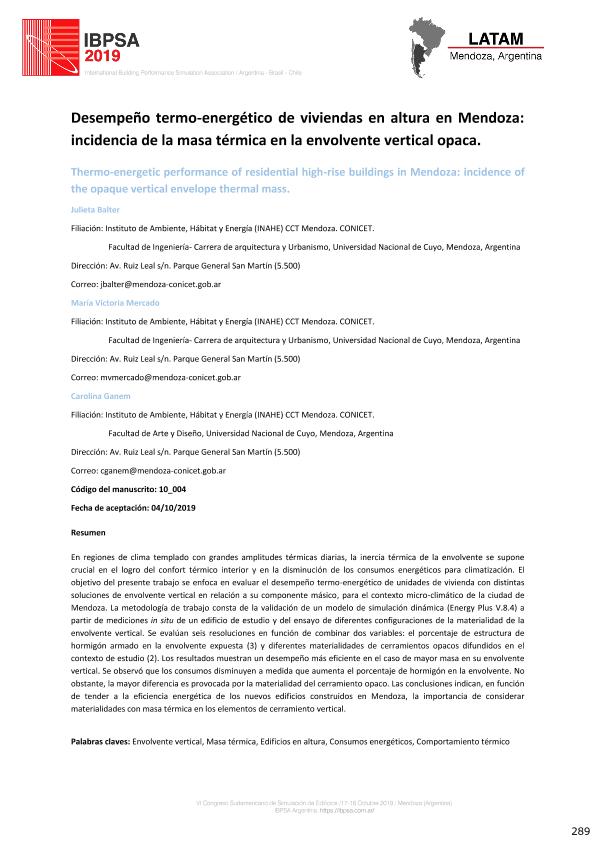Evento
En regiones de clima templado con grandes amplitudes térmicas diarias, la inercia térmica de la envolvente se supone crucial en el logro del confort térmico interior y en la disminución de los consumos energéticos para climatización. El objetivo del presente trabajo se enfoca en evaluar el desempeño termo-energético de unidades de vivienda con distintas soluciones de envolvente vertical en relación a su componente másico, para el contexto micro-climático de la ciudad de Mendoza. La metodología de trabajo consta de la validación de un modelo de simulación dinámica (Energy Plus V.8.4) a partir de mediciones in situ de un edificio de estudio y del ensayo de diferentes configuraciones de la materialidad de la envolvente vertical. Se evalúan seis resoluciones en función de combinar dos variables: el porcentaje de estructura de hormigón armado en la envolvente expuesta (3) y diferentes materialidades de cerramientos opacos difundidos en el contexto de estudio (2). Los resultados muestran un desempeño más eficiente en el caso de mayor masa en su envolvente vertical. Se observó que los consumos disminuyen a medida que aumenta el porcentaje de hormigón en la envolvente. No obstante, la mayor diferencia es provocada por la materialidad del cerramiento opaco. Las conclusiones indican, en función de tender a la eficiencia energética de los nuevos edificios construidos en Mendoza, la importancia de considerar materialidades con masa térmica en los elementos de cerramiento vertical. In regions of temperate climate with large daily thermal amplitudes, the thermal inertia of the enclosure is crucial in achieving internal thermal comfort and in reducing energy consumption for air conditioning. The objective of this work is to evaluate the thermo-energy performance of housing units with different solutions of vertical envelope in relation to its mass component, for the micro-climatic context of the city of Mendoza. The work methodology consists of the validation of a dynamic simulation model (Energy Plus V.8.4) from on-site measurements of a study building and the testing of different configurations of the vertical envelope materiality. Six resolutions were evaluated based on combining two variables: the percentage of reinforced concrete structure in the exposed envelope (3) and different materials of opaque enclosures diffused in the study context (2). The results show a more efficient performance in the case of greater mass in its vertical envelope. It was observed that consumption decreases as the percentage of concrete in the envelope increases. However, the biggest difference is caused by the materiality of the opaque enclosure. The conclusions indicate, in order to tend to the energy efficiency of the new buildings built in Mendoza, the importance of considering materials with thermal mass in the vertical enclosure elements.
Desempeño termo-energético de viviendas en altura en Mendoza: incidencia de la masa térmica en la envolvente vertical opaca
Título:
Thermo-energetic performance of residential high-rise buildings in Mendoza: incidence of the opaque vertical envelope thermal mass
Colaboradores:
Villalba, Ayelén María ; Alchapar, Noelia Liliana
; Alchapar, Noelia Liliana
 ; Alchapar, Noelia Liliana
; Alchapar, Noelia Liliana
Tipo del evento:
Congreso
Nombre del evento:
VI Congreso Latinoamericano de Simulación de Edificios
Fecha del evento:
17/10/2019
Institución Organizadora:
International Building Performance Simulation Association;
Instituto de Ambiente, Hábitat y Energía;
Universidad Nacional de Cuyo. Facultad de Ingeniería;
Título del Libro:
Actas del VI Congreso Latinoamericano de Simulación de Edificios
Editorial:
Instituto de Ambiente, Hábitat y Energía
ISBN:
978-987-47510-0-3
Idioma:
Español
Clasificación temática:
Resumen
Archivos asociados
Licencia
Identificadores
Colecciones
Eventos(INAHE)
Eventos de INSTITUTO DE AMBIENTE, HABITAT Y ENERGIA
Eventos de INSTITUTO DE AMBIENTE, HABITAT Y ENERGIA
Citación
Desempeño termo-energético de viviendas en altura en Mendoza: incidencia de la masa térmica en la envolvente vertical opaca; VI Congreso Latinoamericano de Simulación de Edificios; Mendoza; Argentina; 2019; 289-298
Compartir



